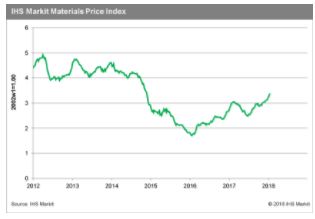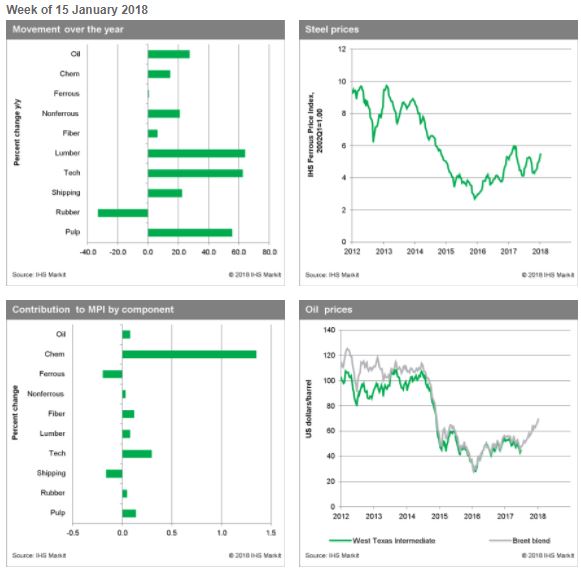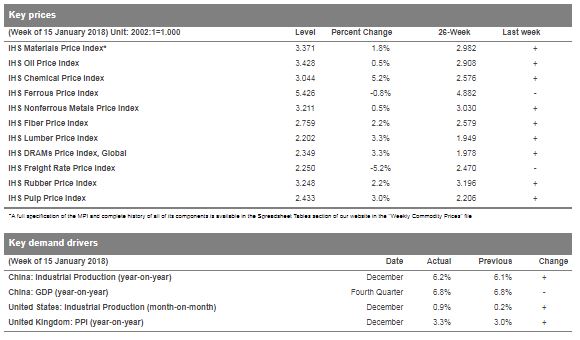| Week ending January 26, 2017 |
Supply concerns give the commodity rally continued strength
|
The MPI sees its third weekly increase of over 1.0%
The IHS Markit Materials Price Index (MPI) increased for the 11th consecutive time last week, rising 1.8%. The MPI is up 16.9% since the current rally began back in October, with prices as measured in the index now back to levels last seen in late 2014. Chemicals prices led the rise, increasing 5.2%, while both lumber and the DRAMS index moved up 3.3%.
Supply concerns pushed up prices across the commodity complex last week. Propylene prices rose sharply as all three dehydrogenation plants in the United States experienced trouble, while freezing temperatures in the Gulf Coast disrupted supply in ethylene markets. In lumber markets, fallout from wildfires in Western Canada continued to put upward pressure on prices. Meanwhile, in DRAMs markets, prices for an older 8GB module chip increased 12.3% due to a spot shortage; this price increase should dissipate over the next couple of weeks.
Data releases reinforced the buoyant mood in commodity markets. In the United States, December industrial production narrowly beat market expectations, coming in at 0.9% month on month (m/m). US consumer sentiment also remains strong, highlighted by the Bloomberg Consumer Comfort Index, which hit a 17-year high of 53.8 last week. In China, the data once again surprised to the upside, with fourth-quarter GDP growing 6.8% year on year (y/y) and industrial production increasing 6.2% y/y in December. Although temporary supply disruptions helped drive prices higher last week, there is no denying the current strength in commodity markets. Conditions have improved since this time last year to be sure, but in many markets prices seem to have run a bit ahead of fundamentals, leading to questions about whether they can be fully sustained.
|
|
|
| | IHS Materials Price Index |  |
|
| | 
| Market Insight
For an overview of the IHS Materials Price Index, view this video.
Get the Materials Price Index delivered to your in-box weekly.
Subscribe here.
|
|  |
| | |
|
| Industrial Materials: Prices |  |
| Key Prices & Demand Drivers |  |
Construction Labor Costs Reach Highest Level in Almost Three Years, IHS Markit Says
|
Construction costs rose again in November, according to IHS Markit and the Procurement Executives Group (PEG). |
The current headline IHS Markit PEG Engineering and Construction Cost Index registered 60.2, supported by strong figures in both the materials/equipment and labor sub-indexes. The materials/equipment price index was 60.9 in November, moving up from the October figure of 58.9. Price increases were widespread. Current subcontractor labor prices rose at a fast pace in November: the index figure came in at 58.5, the highest reading since December 2014. “Subcontractor rates continued to accelerate over November and expectations for future increases reached a five-year high,” said Emily Crowley, principal economist - pricing and purchasing, IHS Markit. “Tightening labor market conditions combined with an uptick in activity are driving expectations of future rate increases. Currently the U.S. South and West are having the most trouble finding workers leading to stronger wage escalation, whereas the end of major projects in Eastern Canada are keeping pressure off of wages in that region.”
| | Learn More |
|
| About IHS Pricing & Purchasing | | The IHS Pricing & Purchasing Service | The IHS Pricing & Purchasing Service enables supply chain cost savings by providing timely, accurate price forecasts and cost analysis. Armed with a better understanding of suppliers' cost structures and market dynamics, organizations can effectively negotiate prices, strategically time buys, and boost the bottom line.
With a database of more than 80,000 historic prices and thousands of price, wage and input cost forecasts, IHS offers more coverage than any other provider in the market. IHS has been providing forecasts of key commodity, labor, and input costs since 1970 -- helping define the purchasing advice industry. | | Learn More |
|
| Commodity Price Forecasts & Supply Chain Cost Benchmarking. Learn More | | |
|
|
|
